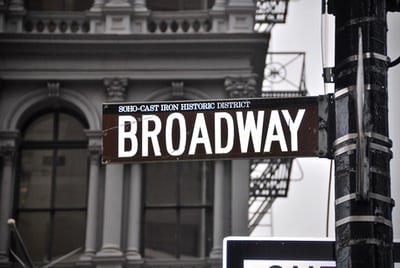The world of musical theatre can be a magical experience of color, music, and enchantment. In addition to the most experienced and talented actors and singers, technical effects and lighting can create an unforgettable evening for viewers. Over the years, theatre and film has diversified in cast, crew, and audience, drawing appeal from larger masses of people. However, Broadway, in addition to theatre and film, through history and especially in modern day and age has had a tendency to pander to white actors and audiences, and has become inadvertently racist, especially through the acts of white-washing and colorblind casting. Although Broadway and the theatre community has increased efforts to diversify and improve experiences for non-white actors and audiences in recent years, there remains a disparate gap between today’s Broadway and a truly colorblind theatre which manifests in the musicals and plays that show on Broadway stages and the audiences that experience these shows.
Broadway Panders to White People
While the cast, crew, and direction of Broadway productions has been steadily changing in terms of racial makeup, it remains majorly white and white-washed, and roles for non-white actors are often stereotyped and limited. In the 2014-2015 show season, there were thirty-four shows running on Broadway[1]. Out of these shows, fourteen had black actors participating in the show. Only eight of these shows had Asian cast members, and only eight had Hispanic members.[2] Thirteen out of the thirty-four shows had an entirely white cast. The makeup of these shows the great disparity between white actors and actors of color. In fact, there were more white actors on Broadway this season than African Americans, Hispanics, Asians, and other actors combined. 74% of actors were white, while only 17.7% were Black, 4.5% were Asian, and only 3.5% were Hispanic. All other races made up 0.2% of the actors on Broadway[3]. Minorities are greatly affected by the nature of Broadway shows and their tendency to cast majority white. The audiences that come to watch Broadway shows in New York do not differ greatly in racial makeup from the actors. 71.4% of Broadway audiences are white, while 9.1% are Asian, 7.0% are Black, 6.8% are Hispanic, and 5.6% are other races[4]. The reason that white audiences flock to Broadway is the abundance of shows that pander to the white experience. This is shown directly through the show Hamilton. Hamilton featured a diverse cast of mainly Hispanic and Black actors, but however, audience turnout did not reflect this diversity[5]. This is because even though Hamilton featured a diverse cast, the plot of the show pandered to an affluent white audience in order to boost profits and gain audience. Though New York City’s population is less than 1/3rd white, the audience of Hamilton was more than 2/3rd white[6]. Even with a diverse cast, a truly culturally relevant storyline is needed to engage audiences of color. Jose Solis is an acclaimed theatre critic who works for the Broadway News. Solis mentioned in an interview that “when [he] [sees] a show with a white friend, people often ask the friend if they brought [him] to the show and ask [him] if it’s [his] first time at the theatre”[7]. Solis’s experience reflects that of many theatregoers of color, who are often assumed to be unknowledgeable about Broadway and theatre. The fact that people automatically assume Solis is a new theatregoer ties directly to his race, seen through the fact that his friend is never asked if they are a new theatregoer. Experience’s like Solis’s are indicative of how highly pervasive internal racism is, especially in the theatre and with theatregoers[8]. However, even though the actors and audiences of Broadway shows are minimally people of color, directors of color are even more underrepresented in the musical theatre world. There are only two black directors who are regular directors on Broadway, Kenny Leon and George C. Wolfe[9]. Leon mentioned in an interview that a “white man with a Tony goes farther than a black man with a Tony”[10]. This statement shows how Broadway values White directors over directors of color, and how Black directors have to work twice or thrice as hard in order to get the same recognition white directors receive. Overall, the cast, crew, direction, and audiences of Broadway shows are severely disproportionate, often times almost fully white.
Problematic Shows are Ignored
Many Broadway productions that feature people of color are problematic within themselves, and often shows written for people of color by people of color are marketed heavily towards white people. The King and I is a critically acclaimed show on Broadway that chronicles a white woman teaching the children of the King of Siam. The show takes on a white savior complex, as the white women changes these Asian children by forcing them to rid themselves of cultural customs, calling them barbaric and odd[11]. She inflicts white western values on the children in order to make them proper and acceptable in society, perpetuating the notion that in order to be successful, one must adhere to white western philosophies and principles[12]. Another show that casts Asians in a negative light is Thoroughly Modern Millie. In this show, the character Mrs. Meers pretends to be a Chinese woman and runs a white slavery ring with two Asian characters named Ching Ho and Bun Foo[13]. The act of perpetuating oneself as a different race is thoroughly discriminatory in itself, and the naming of the Asian characters as Ching Ho and Bun Foo show ignorance and implicit bias towards Asians. In the original version of Andrew Lloyd Weber’s Cats, there was a racial slur pertaining to Chinese people in one of the songs[14]. This has since been removed but shows the overtly racist nature of so-called timeless shows[15].However, shows like these remain the only options available for Asian actors who want to make it on Broadway. All the characters are stereotypical Asians, exactly how the western world caricatures Asian people, characters without any real depth or importance. On Broadway, characters of color are most often stereotypes, like the barbaric foreigner or the strong, angry black man, the drug-dealing Hispanic. Yet, this act of stereotyping thrives because it is the only opportunity for people of color to perform on Broadway. In addition, when there are shows that feature well developed characters of color, the actors of those characters often feel as though they cannot truly express the culture and nature of their character fully[16]. These actors feel as though the white direction and production of the shows leaves them uncomfortable asking the directors questions about the race or cultural aspects of the character they need to incorporate into their performance[17]. This leaves a show feeling unfinished or unprofessional, especially noticeable in the actors of color who were not able to fully develop their characters. Actors of color also often feel as though they cannot bring up these polarizing topics with other actors, as they feel that the white actors will feel that they are being attacked or unfairly called out. Broadway is hostile and unforgiving to actors of color[18]. Ultimately, they only receive roles in stereotypical and dehumanizing roles, and when they do receive a well written role, they are not sure how to construct that role respectfully.
Though Broadway has overall improved in its racial diversity, casting and hiring people of color, the whole industry has lengths to go in order to fully combat racist ideologies and stereotypes, which are especially prevalent in forms of consumable media such as plays and musicals. Racism can be much more striking when on stage or shown to the public, and for that reason, the stereotypes perpetuated by many shows and the overall whiteness of the industry is glaringly apparent to the public. White-washing and colorblind casting are problems that have yet to be addressed by prominent names and backers of the theatre industry. Broadway has changed over the years, but by far, it still needs to improve in order to respect minorities properly.
[1] Onuoha, Mimi. “Broadway Won’t Document Its Dramatic Race Problem, so a Group of Actors Spent Five Years Quietly Gathering This Data Themselves.” Quartz. Last modified December 4, 2016. https://qz.com/842610/broadways-race-problem-is-unmasked-by-data-but-the-theater-industry-is-still-stuck-in-neutral/.
[2] Onuoha, Mimi. “Broadway Won’t Document Its Dramatic Race Problem, so a Group of Actors Spent Five Years Quietly Gathering This Data Themselves.” Quartz. Last modified December 4, 2016. https://qz.com/842610/broadways-race-problem-is-unmasked-by-data-but-the-theater-industry-is-still-stuck-in-neutral/.
[3] Onuoha, Mimi. “Broadway Won’t Document Its Dramatic Race Problem, so a Group of Actors Spent Five Years Quietly Gathering This Data Themselves.” Quartz. Last modified December 4, 2016. https://qz.com/842610/broadways-race-problem-is-unmasked-by-data-but-the-theater-industry-is-still-stuck-in-neutral/.
[4] Onuoha, Mimi. “Broadway Won’t Document Its Dramatic Race Problem, so a Group of Actors Spent Five Years Quietly Gathering This Data Themselves.” Quartz. Last modified December 4, 2016. https://qz.com/842610/broadways-race-problem-is-unmasked-by-data-but-the-theater-industry-is-still-stuck-in-neutral/.
[5] “Hamilton Is Diverse, but Is Its Audience?” El Dorado. Last modified March 3, 2016. https://www.eldo.co/hamilton-is-diverse-but-is-its-audience.html.
[6] “Hamilton Is Diverse, but Is Its Audience?” El Dorado. Last modified March 3, 2016. https://www.eldo.co/hamilton-is-diverse-but-is-its-audience.html.
[7] Smith, Kyle. “Broadway’s Casual Racism.” National Review. https://www.nationalreview.com/corner/broadways-casual-racism/.
[8] Smith, Kyle. “Broadway’s Casual Racism.” National Review. https://www.nationalreview.com/corner/broadways-casual-racism/.
[9] Rao, Sameer. “Kenny Leon Calls out Racism and Inequity in Broadway.” Colorlines. Last modified March 14, 2018. https://www.colorlines.com/articles/kenny-leon-calls-out-racism-and-inequity-broadway.
[10] Rao, Sameer. “Kenny Leon Calls out Racism and Inequity in Broadway.” Colorlines. Last modified March 14, 2018. https://www.colorlines.com/articles/kenny-leon-calls-out-racism-and-inequity-broadway.
[11] “The King and I (musical) Plot and Summary.” Stage Agent. https://stageagent.com/shows/musical/836/the-king-and-i.
[12] “The King and I (musical) Plot and Summary.” Stage Agent. https://stageagent.com/shows/musical/836/the-king-and-i.
[13] “Thoroughly Modern Millie Musical.” MTI Shows. https://www.mtishows.com/thoroughly-modern-millie.
[14] Huddleston, Tom, Jr. “Cats Is Returning to Broadway, minus One Racist Song.” Fortune. https://fortune.com/2016/08/04/cats-broadway-revival/.
[15] Huddleston, Tom, Jr. “Cats Is Returning to Broadway, minus One Racist Song.” Fortune. https://fortune.com/2016/08/04/cats-broadway-revival/.
[16] “Playwrights of Color, White Directors, and Exposing Racist Policy.” Howlround. Last modified August 29, 2019. https://howlround.com/playwrights-color-white-directors-and-exposing-racist-policy.
[17] “Playwrights of Color, White Directors, and Exposing Racist Policy.” Howlround. Last modified August 29, 2019. https://howlround.com/playwrights-color-white-directors-and-exposing-racist-policy.
[18] “Playwrights of Color, White Directors, and Exposing Racist Policy.” Howlround. Last modified August 29, 2019. https://howlround.com/playwrights-color-white-directors-and-exposing-racist-policy.
[19] “Getting Candid about Inclusion with Some of Broadway’s Most Powerful Players.” Backstage. Last modified April 13, 2017. https://www.backstage.com/magazine/article/getting-candid-inclusion-broadways-powerful-players-4864/.
[20] Newton, Omari. “Omari Newton: ‘Color Blind Casting’ Is an Absurd and Insidious Form of Racism.” YVR Screen Scene. https://www.yvrscreenscene.com/home/2019/5/1/omari-newton-colour-blind-casting-is-an-absurd-and-insidious-form-of-racism.
[21] Newton, Omari. “Omari Newton: ‘Color Blind Casting’ Is an Absurd and Insidious Form of Racism.” YVR Screen Scene. https://www.yvrscreenscene.com/home/2019/5/1/omari-newton-colour-blind-casting-is-an-absurd-and-insidious-form-of-racism.
[22] Newton, Omari. “Omari Newton: ‘Color Blind Casting’ Is an Absurd and Insidious Form of Racism.” YVR Screen Scene. https://www.yvrscreenscene.com/home/2019/5/1/omari-newton-colour-blind-casting-is-an-absurd-and-insidious-form-of-racism.
[23] “Getting Candid about Inclusion with Some of Broadway’s Most Powerful Players.” Backstage. Last modified April 13, 2017. https://www.backstage.com/magazine/article/getting-candid-inclusion-broadways-powerful-players-4864/.




